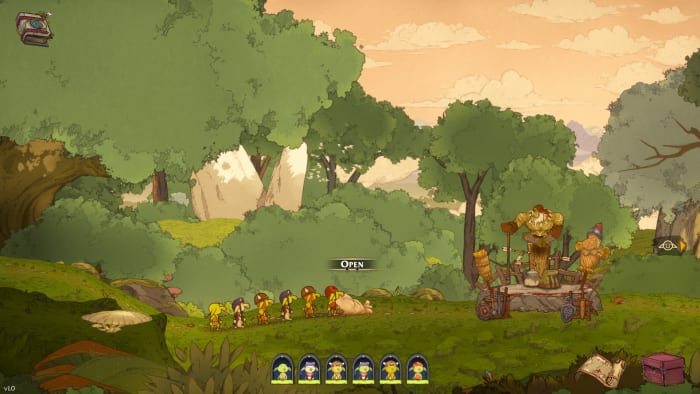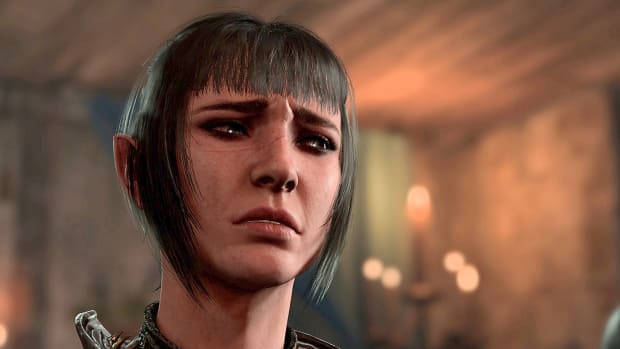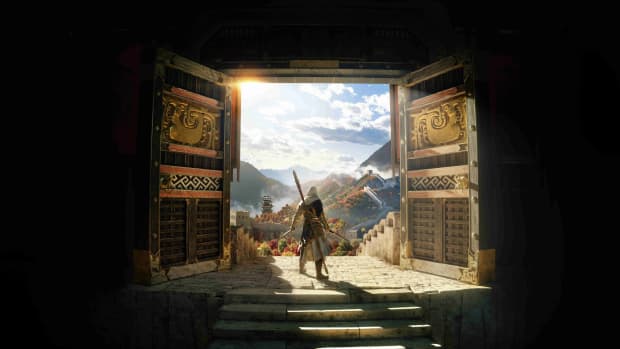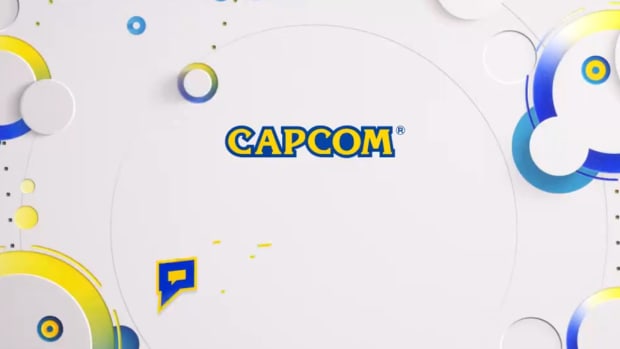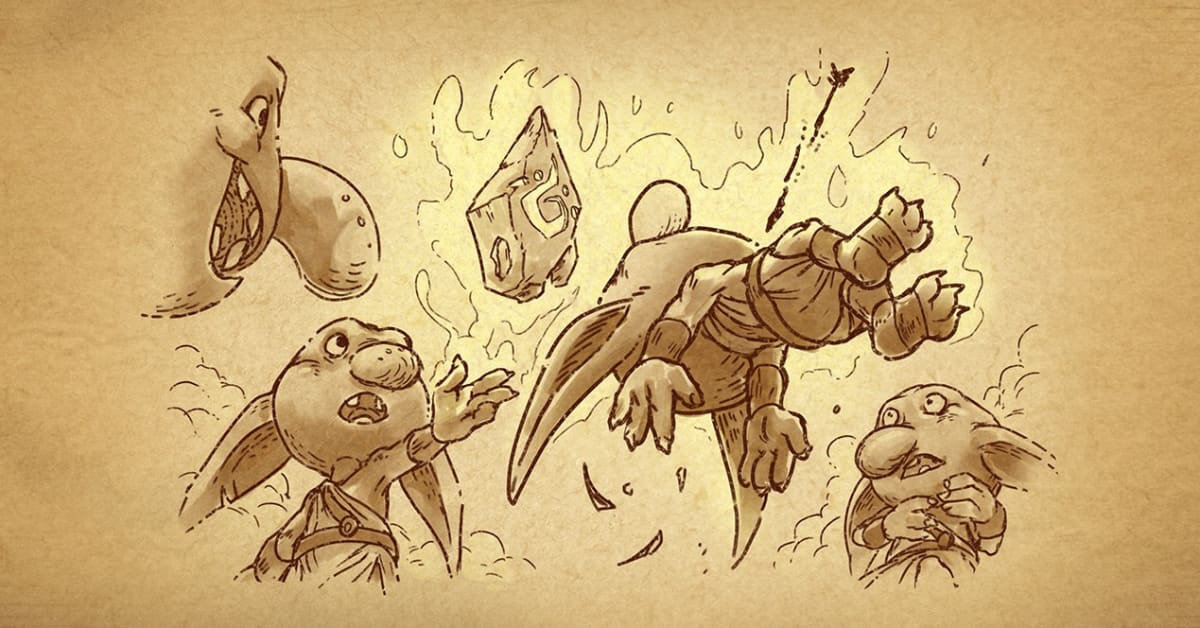
Goblin Stone review: Darkest Dungeon but wholesome
There is always something fun and interesting about stories that subvert conventional tropes and expectations. In fantasy stories, adventurers may be rough around the edges, but always have a heart of gold and help out the weak, while goblins are stupid and cruel creatures, too weak to be a real threat to anyone other than the innocent civilians on whom they prey. Goblin Slayer turned that up to eleven and had you cheering the protagonist on as he ruthlessly exterminated entire tribes. Goblin Stone plays into that with the opening of the game letting you play as a group of adventurers exploring a dungeon and slapping around some goblins. Only when the narrator – voiced by the soothing James Smilie – decides he’d rather check out what the fleeing goblins are up to do we stray away from the usual path of fantasy storytelling.
Hunted to near-extinction by adventurers and predators, the goblins need to rebuild their home and it’s up to the player to assist them with this task. Developed by Orc Chop Games, this indie game takes much of its inspiration from Darkest Dungeon. I already mentioned the narrator – he doesn’t only present the story, accompanying hand-drawn cutscenes, but sticks with you as you crawl through dungeons, commenting on the highs and lows of your fortune. Smilie doesn’t put quite as much grit into his voice as his Darkest Dungeon counterpart Wayne June, but it’s a great, grandfatherly performance nevertheless. I only wish he’d have been given a few more lines to say for battles and exploration for additional variety.
That’s a bit of a theme with this game and probably comes down to the indie budget. Enemies, for example, could use more of a mix-up. By the time you’ve worked your way through the first area mostly populated by human adventurers, wolves, and spiders, you’re going to cry for joy when encountering some basic zombies.
Just like in Darkest Dungeon, you’re building up your base with the help of resources you pick up on expeditions. As your lair grows, gets additional rooms, and is upgraded, you get access to an array of additional bonuses during expeditions as well as advanced goblin classes. It’s the usual gameplay loop: You check out which resources you currently need, put together your team, and then pick the corresponding area to explore. There is also an overarching story going on, which includes special missions and breaks the loop from time to time.
Your base provides things like a larder to store resources or a campground to sell treasures and recruit new goblins. Building guilds for specific classes allows you to upgrade their capabilities and manage which skills they’ll bring to the next expedition. As everyone knows, a good indie title needs to shoehorn a deck-building mechanic into its systems, and so these skills are portrayed as a deck of cards. Overall, this works quite well. My only gripe is that I can’t adjust the decks of individual goblins – any changes apply to a class as a whole, making weapons the only way to differentiate members of the same job. Available types include all the classics, like tanky Guards, damage-dealing Raiders, and healing Shamans. There is even an incentive not to train all of your goblins in a specific class and leave them as Peons, as these provide additional inventory space for expeditions – and if you’ve played Darkest Dungeon, you’ll know that’s valuable real estate.
A key feature of Goblin Stone’s base is the warren. Here’s where you breed new goblins to join your forces – sheathe your shortsword, Goblin Slayer: No prisoners are involved. Choosing two goblins as parents, you can spawn a new generation of creatures that inherit genetic attributes from them. There is a whole list of these to be discovered, so it’s always smart to check out the potential candidates on the campgrounds or seek out and free imprisoned goblins on expeditions to add new traits to your gene pool. While individual goblins won’t level up and become stronger – in this sense, the classic trope is preserved – you can use targeted breeding to create more powerful specimens over time, specializing their traits and stat distributions to fill certain roles. Goblin looks are also inherited from their parents, giving you another fun area to explore.
While some of the progression in the game feels a little lacking – you can’t upgrade weapons at your base, for example, as upgrades happen ad hoc during expeditions and are temporary (your base’s forge instead boosts those upgrades; roguelike elements, and all that) – this is a gem of a system, feeling great to use while remaining true to the theme. Another weird progression system pertains to the lair as a whole, as it requires souls to level up. These can be gained from dead or retired goblins. On the one hand this makes losses in battle a little less bad, as it helps your base grow. On the other hand it punishes you for not making mistakes. Sure, you can get souls by sending goblins into retirement in your quarters (which makes them unavailable for any expeditions, but keeps them around for breeding), but it feels awful to retire one of your ace companions. Again, it’s thematic – you’ll need to make way for those stronger, younger warriors to tackle more difficult quests – but it’s bizarre from a gameplay standpoint.
Speaking of retiring goblins: The UI and filter systems could use a bit of work, as you can’t really search for specific goblins on your ever-growing list of characters. There are some basic filters, but I’d really love an option that highlights those with a mortally wounded debuff – as these are the prime candidates for retirement, having their maximum HP halved permanently after almost facing death on an expedition.
Expeditions work similarly to Darkest Dungeon, though you don’t have the whole preparation and sanity aspect. I told you, it’s more wholesome. You lead your adorable troop through dungeons with diverging paths, gathering resources, resolving events, and defeating enemies.




Combat is practically turn-based, but is still neatly portrayed in real time in the form of a meter on the top of the screen, which constantly has allies and enemies move towards the center. When they’re there, they can take action. Each action has a certain stamina cost associated with it, which determines where they line up when re-queuing on the action meter. A powerful move like Exterminate costs five stamina points, so a goblin executing it will queue up right at the end and it’ll take longer for them to take another action, whereas a move costing just one stamina will see the goblin back in the center much sooner.
Formation plays a big role in the game, just like in its inspiration. Many attacks will simply target the first character in line, so you’ll want to ensure that your rotation brings tanky goblins into the line of fire in time. Other attacks target the second and third character, and so on, so managing where your units are at each time is key. In most games, stunning or knocking back your own characters is a bad idea, but in Goblin Stone this can keep them out of harm’s way or buy a regeneration spell some more time to restore HP. It brings a neat dynamic into combat. Again, it’s thematically consistent for this gaggle of goblins to smack each other to push into the queue.

Actions are shown as cards and you can see that the costs correspond to the numbers on the meter at the top of the screen.
Orc Chop Games
Naturally, there are plenty of combo opportunities and synergies to explore between classes. You can use your Guards, Peons, or Shamans to set up slows or stuns so that your Raiders can use an especially powerful move, and so on.
As mentioned before, the mixing of enemy types could be a little more exciting, and things like the narrator’s lines and background music could be more varied as well. As great as both of these elements are, I want more of them.
Visually, Goblin Stone is fantastic. It’s got this hand-drawn, adorable art style that makes it feel like it’s a storybook come to life. Cutscenes, in fact, are literal pages from a book. Slight hiccups on a technical level, such as stutters when interacting with merchants or rooms in the lair, are present, but I’ve not experienced any bugs related to gameplay, indicating a polished build.
Goblin Stone is a wholesome version of Darkest Dungeon, ticking all the same boxes without being a blind copycat – meaningful additions like the breeding system and its narrative ensure that it’s a unique experience that can stand on its own. Though the restrictions of its budget do show here and there, it’s clearly a labor of much love and craftsmanship that will keep you entertained for many hours.
Score: 8/10
Version tested: PC.
Goblin Stone is out for PC via Steam and Epic Games Store on March 12, 2024.





